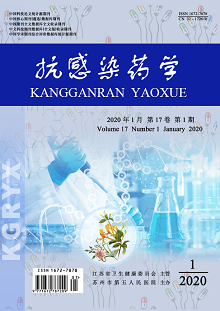WANG Ya-lei
Objective: To analyze the distribution of pathogenic bacteria in acute appendicitis and their resistance to antibiotics. Methods: The Data of 324 patients with acute appendicitis admitted for surgical treatment from June 2014 to June 2018 were extracted, and the results of bacterial culture in the secretion samples of the surgical incision site were collected, and the distribution of pathogenic bacteria and their drug resistance were analyzed. Results: Among 324 patients undergoing acute appendicitis surgery, 360 pathogenic bacteria were detected in the infected secretions from the incision, among which 237 Gram-negative bacteria accounted for 65.83%, 88 Gram-positive bacteria accounted for 24.45% and 35 fungi accounted for 9.72%. Among the Gram-negative bacteria, Escherichia coli (97 strains, 26.94%), Acinetobacter baumannii (44 strains, 12.22%), Pseudomonas aeruginosa (27 strains, 7.50%) and Klebsiella pneumoniae (30 strains, 8.33%) accounted for the largest proportion. Staphylococcus aureus (55 strains, 15.58%) and Enterococcus faecalis (18 strains, 5.00%) were the major Gram-positive strains. Among the fungi, Candida albicans (17 strains, 4.72%) and Trichoderma (13 strains, 3.61%) were the most important strains. The results of drug susceptibility test showed that (1) the sensitivity of Escherichia coli in Gram-negative bacteria to piperacillin, ciprofloxacin, aztreonam and levofloxacin was higher, 82.47%, 77.32%, 85.56% and 71.13%, respectively, while the resistance of Acinetobacter bauman to cefoperazone and aztreonam was 97.73% and 86.36%, respectively. Klebsiella pneumoniae had a higher sensitivity to aztreonam (86.67%), while Pseudomonas aeruginosa had a higher sensitivity to piperacillin, ciprofloxacin and aztreonam (96.3%, 81.48% and 92.59%, respectively). (2) among Gram-positive bacteria, Staphylococcus aureus had higher sensitivity to vancomycin, imipenem, linezolid and cefoxitin, while Enterococcus faecalis had higher sensitivity to imipenem, linezolid and cefoxitin. Conclusion: Based on the results of drug susceptibility test for postoperative wound infection, rational treatment should be made with aztreonam (infection caused by Gram-negative bacteria) or imipenem, linezolid, cefoxetine and other drugs (infection caused by Gram-positive bacteria) to ensure the effectiveness of medication.
